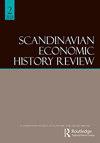Med skibet i kroppen. Mennesker og maritimt miljø i Det sydfynske Øhav 1750–1950
IF 0.5
Q4 ECONOMICS
引用次数: 0
Abstract
countryside sites. The purpose is to study the remains of production which can give clues regarding location, intensity and the type of production that took place. Ferrous and non-ferrous metalworking took place at numerous places often simultaneously. The production intensified in the Viking age as a response to an increased demand for iron. Contrary to many previous ideas on ferrous and non-ferrous metalworking, it is shown that this production took place at the same areas/buildings on the excavated sites. Production seems often to have been temporal or occasional and both types of crafts can have been performed by the same individuals. Viking age metal production in the countryside was thus according to Sahlén small-scale and intended for local use. Thus, iron for export was connected to central places and early towns. The last and fifth chapter, Interactions and infrastructure – driving forces and organization behind the Viking Age trade networks in the Baltic and beyond, by the archaeologist Charlotte Hedenstierna-Jonson, aims to identify sites involved in trade in the Baltic, but also to contextualise some of the commodities traded, as well as discussing the driving forces behind the trading networks of the Viking age. It also functions as a summary to the other four chapters of the book. This article does not only discuss iron, rather trading commodities in general, of which iron and iron products were two. Focus is also on the eastern Baltic and the regions further east. The establishment of trading centres and how commodities as fur, textiles and iron exchanged hands along the trading routes is discussed. The result shows that there was a close connection between the development of the first town-like structures in the Baltic region and the presence of advanced crafts. The exchange of raw materials and finished goods, as well as skilled labourers are discussed. The Viking expansion was driven by factors like trade, an urge for acquiring wealth and power. The steady increase of the need for iron for new and heavier products, promoted this development. Even if the two first chapters in the book do not focus on the Viking age to the same degree as the last three, the book nevertheless gives a thorough presentation of the importance of metalworking for the Viking society. The scope of the book is mainly archaeological, and especially the last three chapters give new insights regarding the topic. Especially the combination of the results from Zachrisson’s and Sahlén’s studies highlights the different but complementary aspects of the topic. The interested reader finds much valuable reading in this book. At the same time, it is obvious that the topic can be developed further in the future.船在他的身体里。1750-1950年南富宁群岛的人与海洋环境
农村的网站。目的是研究生产的遗迹,这可以提供有关发生的生产的地点、强度和类型的线索。黑色金属和有色金属的加工通常同时在许多地方进行。在维京时代,由于对铁的需求增加,这种生产得到了加强。与以前关于黑色金属和有色金属加工的许多想法相反,研究表明,这种生产发生在挖掘遗址的同一区域/建筑物中。生产似乎经常是暂时的或偶然的,这两种类型的手工艺品可能是由同一个人完成的。因此,根据sahlsamin的说法,维京时代农村的金属生产规模很小,主要供当地使用。因此,用于出口的铁与中心地区和早期城镇相连。最后和第五章,互动和基础设施——波罗的海及其他地区维京时代贸易网络背后的驱动力和组织,由考古学家夏洛特·海登斯蒂娜-琼森(Charlotte hedenstiena - jonson)撰写,旨在确定参与波罗的海贸易的地点,同时也将一些商品交易置于背景中,并讨论维京时代贸易网络背后的驱动力。它也是本书其他四章的总结。这篇文章不仅仅讨论铁,而是一般的交易商品,其中铁和铁产品是两种。重点还放在波罗的海东部和更东边的地区。讨论了贸易中心的建立,以及毛皮、纺织品和铁等商品如何在贸易路线上交换。结果表明,波罗的海地区最早的城镇结构的发展与先进工艺的出现有着密切的联系。讨论了原材料和制成品的交换以及熟练工人的交换。维京人的扩张是由贸易等因素驱动的,他们渴望获得财富和权力。新的和更重的产品对铁的需求不断增加,促进了这一发展。即使书中的前两章没有像后三章那样关注维京时代,这本书仍然全面地介绍了金属加工对维京社会的重要性。这本书的范围主要是考古的,特别是最后三章给出了关于这个主题的新见解。尤其是将Zachrisson和sahlsamin的研究结果结合起来,突出了该主题的不同但互补的方面。感兴趣的读者在这本书中发现许多有价值的读物。同时,很明显,该课题在未来还可以进一步发展。
本文章由计算机程序翻译,如有差异,请以英文原文为准。
求助全文
约1分钟内获得全文
求助全文
来源期刊

SCANDINAVIAN ECONOMIC HISTORY REVIEW
ECONOMICS-
CiteScore
1.60
自引率
16.70%
发文量
20
期刊介绍:
Scandinavian Economic History Review publishes articles and reviews in the broad field of Nordic economic, business and social history. The journal also publishes contributions from closely related fields, such as history of technology, maritime history and history of economic thought. Articles dealing with theoretical and methodological issues are also included. The editors aim to reflect contemporary research, thinking and debate in these fields, both within Scandinavia and more widely. The journal comprises a broad variety of aspects and approaches to economic and social history, ranging from macro economic history to business history, from quantitative to qualitative studies.
 求助内容:
求助内容: 应助结果提醒方式:
应助结果提醒方式:


